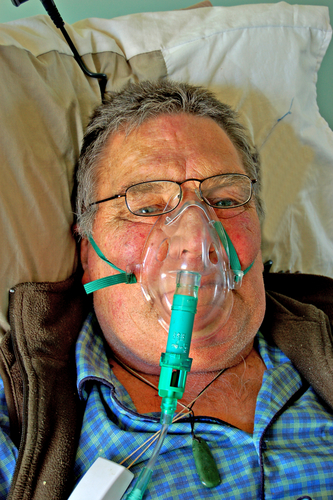Ness Ziona, Israel, based plasma-derived protein therapeutics company Kamada Ltd. this week announced preliminary top-line results from its recently completed Phase II/III pivotal clinical trial in Europe and Canada of the Company’s proprietary inhaled Alpha-1 Antitrypsin (AAT) therapy for the treatment of Alpha-1 Antitrypsin Deficiency (AATD or inherited emphysema).
According to the Canadian Lung Association, Alpha-1 antitrypsin deficiency is a genetic disease that runs in families, AKA AAT deficiency or Alpha-1. People with Alpha-1 antitrypsin deficiency don’t have enough of a special protein that protects the lungs and liver. Over time, they can get can get permanent lung damage and develop COPD, chronic obstructive pulmonary disease. They can also get liver damage.
The American National Heart Lung and Blood Institute notes that Alpha-1 antitrypsin, also called AAT, is a protein made in the liver. Normally, the protein travels through the bloodstream, helping protect the body’s organs from the harmful effects of other proteins — the lungs being one of the main organs that the AAT protein protects. AAT deficiency occurs if the AAT proteins made in the liver aren’t the right shape. They get stuck inside liver cells and can’t get into the bloodstream. As a result, not enough AAT proteins travel to the lungs to protect them. This increases the risk of lung disease. Also, because too many AAT proteins are stuck in the liver, liver disease can develop.
Severe AAT deficiency occurs if blood levels of the AAT protein fall below the lowest amount needed to protect the lungs.
Some people with severe AAT deficiency develop emphysema, a serious lung disease in which damage to the airways makes it hard to breathe, often when they’re only in their forties or fifties. The disease occurs in all ethnic groups, yet most often in Caucasians of European descent. It is not known how many people have AAT deficiency and many people who have the condition may not know they have it. According to the National Institutes of Health, estimates of AAT deficiency disease incidence range from about 1 in every 1,600 people to about 1 in every 5,000 people.
Kamada says endpoints selected for its Phase II/III trial were based on scientific advice from the European Medicines Agency (EMA) and include those deemed to be clinically meaningful, such as frequency, time to first, duration and severity of exacerbation events, among others. They report that a preliminary analysis of the results indicates clinically meaningful signs for inhaled AAT efficacy as well as additional positive signs in specific study populations. In addition in a very important secondary end point, frequency of severe exacerbation was approximately 50% lower in the AAT group versus placebo. With regards to the primary endpoint of time to first moderate or severe exacerbation, Kamada notes that early data do not show differences between the two treatment groups in th multicenter randomized, double-blind, placebo-controlled study in which its inhaled formulation of human AAT was used to treat AATD in more than 165 patients.
The study involved the inhalation of 160 mg of human AAT or placebo twice daily via the eFlow device for 50 weeks, and eligible patients were given the option to participate in a 50-week open-label extension study. The primary endpoint of the study is the difference in exacerbation events between the two groups at one year and is 80% powered to demonstrate a 20% difference. Power is based on the number of events collected during the study. Secondary endpoints include additional parameters of exacerbation events, pulmonary function tests and safety. Additional exploratory endpoints include CT densitometry in subset of subjects, Quality of Life measurements and more.
In September, 2013, the Company issued a fifth interim safety report based on data of all patients in the trial as of that date, which was supportive and consistent with previous reports and demonstrated a high safety and tolerability profile. At that time, observed adverse events were related to the expected known symptoms of Inherited Emphysema. No allergic reactions or signs of any risk related to the use of the inhalation device were observed.
Forced Expiration Volume in one second (FEV1) data, a secondary and safety endpoint, indicated positive trends in improvement. Additionally, the data showed efficacy in certain subsets of patient populations. Safety data of inhaled AAT was supportive and consistent with previous reports and demonstrated a high safety and tolerability profile. Based on the initial review, the Company believes that some of the data may support the issuance of new patents for the product.
The Company is continuing to analyze the data in accordance with the statistical plan and intends to release a more profound set of results in third quarter of 2014.
However, based on preliminary trial results, Kamada reported this week partial and early stage data regarding the primary endpoint and certain key secondary endpoints. They say they have detected clinically meaningful signs for inhaled AAT efficacy as well as additional positive signs in specific study populations, and are examining these data further to better understand the results and to assure the information is valid and correlates with additional clinical parameters
 Kamada Vice President of Clinical Development and Intellectual Property Pnina Strauss notes that: “Severe exacerbations involve hospitalizations and deterioration of respiratory symptoms including breathlessness, increased sputum volume, change in sputum color and/or purulence. A decrease in severe exacerbations is a significant benefit to patients and will lower the overall cost of healthcare, which includes usage of drugs and hospitalization, among others. We believe the existing data support a regulatory filing in Europe, and will continue as planned to meet with the EMA according to the centralized procedure for licensure during the fourth quarter of this year.”
Kamada Vice President of Clinical Development and Intellectual Property Pnina Strauss notes that: “Severe exacerbations involve hospitalizations and deterioration of respiratory symptoms including breathlessness, increased sputum volume, change in sputum color and/or purulence. A decrease in severe exacerbations is a significant benefit to patients and will lower the overall cost of healthcare, which includes usage of drugs and hospitalization, among others. We believe the existing data support a regulatory filing in Europe, and will continue as planned to meet with the EMA according to the centralized procedure for licensure during the fourth quarter of this year.”
 “This is an important study with encouraging data that will influence our understanding of the disease and answer an important question for long-term patient management, and may serve as the entry point to authorize inhaled treatment for the AATD population,” says Rob Stockley, MD, DSc, a Professor of Medicine at the University Hospital Birmingham and Director of Research and Development for the University Hospital Birmingham, the NHS Foundation Trust, and Director of the Lung Immuno Biochemical Research Laboratory at Birmingham, U.K. and a lead investigator in the Kamada trial. “The data is preliminary and needs to be analyzed in greater detail to determine the importance of these initial signs and trends with the aim of having a relevant and user-friendly treatment for patients in the near future.”
“This is an important study with encouraging data that will influence our understanding of the disease and answer an important question for long-term patient management, and may serve as the entry point to authorize inhaled treatment for the AATD population,” says Rob Stockley, MD, DSc, a Professor of Medicine at the University Hospital Birmingham and Director of Research and Development for the University Hospital Birmingham, the NHS Foundation Trust, and Director of the Lung Immuno Biochemical Research Laboratory at Birmingham, U.K. and a lead investigator in the Kamada trial. “The data is preliminary and needs to be analyzed in greater detail to determine the importance of these initial signs and trends with the aim of having a relevant and user-friendly treatment for patients in the near future.”
“We are encouraged by the significant reduction in severe exacerbation rates as well as the positive trends we are seeing in certain patient sub-populations. We look forward to receiving the complete final analysis in the coming months and to receiving the results from the ongoing open-label extension study. We believe these clinically meaningful findings to date may support our efforts to bring inhaled AAT to patients with AATD in Europe. We believe that based on efficacy and ease of use we shall have a competitive advantage in a one billion dollar market, notes David Tsur, co-Founder and Chief Executive Officer of Kamada, in the release. “We thank the trials principal investigators and patients for their commitment to this study and look forward to advancing our inhaled AAT for the benefit of patients suffering from this genetic deficiency.”
Kamada’s Phase II/III Clinical Trial Design
The multicenter randomized, double-blind, placebo-controlled study evaluated the safety and efficacy of Kamada’s inhaled formulation of human AAT to treat AATD in 168 patients. The study involved the inhalation of 160 mg of human AAT or placebo twice daily via the eFlow device for 50 weeks. The primary endpoint of the study is time to the first moderate or severe exacerbation event between the two groups at one year, and the study is 80% powered to demonstrate a 20% difference. Secondary endpoints include additional parameters of exacerbation events, pulmonary function tests and safety. Additional exploratory endpoints include CT densitometry in a subset of subjects, Quality of Life measurements and more.
Next: An Open-Label Extension Study
Eligible patients from this Phase II/III trial were given the option to participate in a 50-week, open-label safety study, and a majority of eligible patients have consented to participate in this study. The Company expects to use the additional data from this study as part of the regulatory submissions.
“Enrollment rates for patients eligible for the open-label extension study were high, with patients in the study continuing to be treated. We believe these high enrollment rates, as well as the additional treatment time on the drug, further support patient and physician preference and acceptance of an inhaled treatment for AATD,” comments Mr. Tsur.
Phase 2 U.S. Clinical Trial of Inhaled AAT to Treat Alpha-1 Antitrypsin Deficiency
In March, Kamada Ltd. announced initiation of a new Phase 2 U.S. clinical trial of its proprietary inhaled Alpha-1 Antitrypsin (AAT) therapy for the treatment of Alpha-1 Antitrypsin Deficiency (AATD, or Inherited Emphysema).
This trial is a double-blind, placebo-controlled study evaluating the safety and efficacy of AAT by inhalation. The study will measure AAT levels in the lung and serum as well as additional inflammatory biomarkers in 36 AATD patients, and involves the inhalation of 80 mg or 160 mg of human AAT or placebo twice daily via the eFlow device for 12 weeks. All subjects will be able to enter an additional 12-week open-label extension study with the active drug to further assess safety and tolerability.
“We are very excited to initiate this U.S. study of our inhaled AAT to treat AATD, which represents a potentially revolutionary, user-friendly, convenient and efficient treatment compared with the current AAT treatment that requires weekly invasive, intravenous infusions. The U.S. market offers a significant opportunity to bring an inhaled therapy to patients suffering from this genetic lung disease, not merely as a more user friendly treatment, but also because the targeted delivery and treatment rationale directly to the lung are expected to enhance efficacy. Initiating this U.S. clinical study is an important step in our global strategy to commercialize our novel, inhaled human AAT,” observes Kamada’s David Tsur.
The Phase 2/3 study involves the inhalation of 160 mg of human AAT or placebo daily via a dedicated, product-adjusted eFlow device for 50 weeks. Eligible patients were given the option to participate in a subsequent 50-week open-label extension study in which all patients receive the active treatment. The primary endpoint of the study is the difference in exacerbation events between the two groups at one year. Secondary endpoints include additional parameters of exacerbation events, pulmonary function tests and safety. Exploratory endpoints include CT densitometry in a subset of subjects, Quality of Life measurements and others. Full description of the study is available at www.clinicaltrials.gov.
“We intend to use data from this U.S. study along with the data from our European Phase 2/3 study to support a BLA license filing with the U.S. Food and Drug Administration. Positive data from the Phase 2/3 study will also accelerate the variety of strategic options we are considering in the U.S., including licensing and/or proprietary sales by Kamada,” says Mr. Tsur.
Kamada’s robust clinical development program also includes plans to initiate a U.S. Phase 2 clinical trial of its inhaled AAT to treat Cystic Fibrosis in the second half of 2014. The Company is also conducting a Phase 2/3 trial of it intravenous AAT to treat Type-1 diabetes, with interim data expected in 2016. The Company recently completed enrollment of a U.S. Phase 2/3 clinical study of its KamRAB as a post-exposure prophylaxis (PEP) treat rabies and product launch in the U.S. is expected in 2015.
Commercialization of Inhaled AAT for the Treatment of AATD
In August 2012 Kamada signed an exclusive agreement for the distribution of its inhaled AAT for the treatment of AATD in Europe and with Chiesi Farmaceutici S.p.A, a fully integrated European pharmaceutical company focused on respiratory disease and special care products. Under the agreement, Kamada is eligible to receive milestone payments of up to $60 million, subject to achievement of certain regulatory and sales targets.
Recently, Kamada has initiated a U.S. Phase II clinical trial with its inhaled AAT for AATD, and expects that the data from the European trial together with the data from the U.S trial will support licensure application in the U.S. and additional territories.
Conference Call
Kamada management’s May 16 conference call discussing these results and answering investor questions was webcast live and archived on the Company’s website at: http://www.kamada.com. Replay of the conference call will be accessible through May 22, 2014, by dialing (855) 859-2056 (domestic) or (404) 537-3406 (international) and referencing conference ID number 47092646. The call will also be archived for 90 days on the Company’s website at: http://www.kamada.com.
eFlow Technology and PARI Pharma
The Company’s inhaled AAT is delivered by an investigational eFlow Nebulizer System developed by PARI Pharma and optimized specifically for Kamada. The optimized device uses eFlow Technology to enable highly efficient aerosolization of medication including liposomal formulations via a vibrating, perforated membrane that includes thousands of laser-drilled holes. Compared with other nebulization technologies, eFlow Technology is claimed to produce aerosols with a very high density of active drug, a precisely defined droplet size and a high proportion of respirable droplets delivered in the shortest possible period of time. eFlow Technology is not an ultrasonic nebulizer technology and is not a general purpose electronic aerosol generator nebulizer technology. Combined with its quiet mode of operation, small size, light weight and battery use, Kamada affirms that eFlow Technology reduces the burden of taking daily, inhaled treatments.
Sources:
Kamada Ltd.
American National Heart Lung and Blood Institute
Canadian Lung Association


